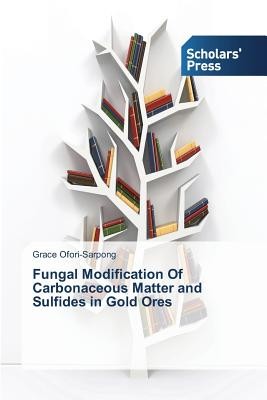
- We will send in 10–14 business days.
- Author: Grace Ofori-Sarpong
- Publisher: Scholars' Press
- Year: 2013
- Pages: 224
- ISBN-10: 363970214X
- ISBN-13: 9783639702149
- Format: 15.2 x 22.9 x 1.3 cm, softcover
- Language: English
- SAVE -10% with code: EXTRA
Fungal Modification Of Carbonaceous Matter and Sulfides in Gold Ores (e-book) (used book) | bookbook.eu
Reviews
Description
Gold ores can be classified broadly as non-refractory (alluvial and free-milling) and refractory from a metallurgical standpoint depending on the mineralogy and the ease of gold extraction. The major problem of refractoriness centres on the presence of sulfides and/or carbonaceous matter. In sulfidic refractory gold ores, tiny gold particles may be highly disseminated and locked up within the grain boundaries or fractures of sulfides such as pyrite and arsenopyrite, thus requiring decomposition for gold liberation. The presence of carbonaceous matter (CM) in gold ores leads to loss of dissolved metal via the ability of CM to adsorb gold from gold-impregnated solution. Pretreatment is therefore required to deactivate the CM. Though there have been several studies on microbial pretreatment of refractory ores, available literature indicates that microbial degradation of both sulfides and CM in a single-stage process has not achieved much success. This book presents research outcome on the use of Phanerochaete chrysosporium to effectively reduce the gold adsorption (preg-robbing) nature of CM on one hand, and decompose sulfides on the other thus leading to enhanced gold recovery.
EXTRA 10 % discount with code: EXTRA
The promotion ends in 16d.21:54:26
The discount code is valid when purchasing from 10 €. Discounts do not stack.
- Author: Grace Ofori-Sarpong
- Publisher: Scholars' Press
- Year: 2013
- Pages: 224
- ISBN-10: 363970214X
- ISBN-13: 9783639702149
- Format: 15.2 x 22.9 x 1.3 cm, softcover
- Language: English English
Gold ores can be classified broadly as non-refractory (alluvial and free-milling) and refractory from a metallurgical standpoint depending on the mineralogy and the ease of gold extraction. The major problem of refractoriness centres on the presence of sulfides and/or carbonaceous matter. In sulfidic refractory gold ores, tiny gold particles may be highly disseminated and locked up within the grain boundaries or fractures of sulfides such as pyrite and arsenopyrite, thus requiring decomposition for gold liberation. The presence of carbonaceous matter (CM) in gold ores leads to loss of dissolved metal via the ability of CM to adsorb gold from gold-impregnated solution. Pretreatment is therefore required to deactivate the CM. Though there have been several studies on microbial pretreatment of refractory ores, available literature indicates that microbial degradation of both sulfides and CM in a single-stage process has not achieved much success. This book presents research outcome on the use of Phanerochaete chrysosporium to effectively reduce the gold adsorption (preg-robbing) nature of CM on one hand, and decompose sulfides on the other thus leading to enhanced gold recovery.


Reviews